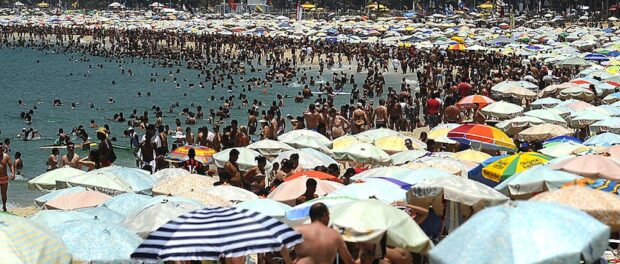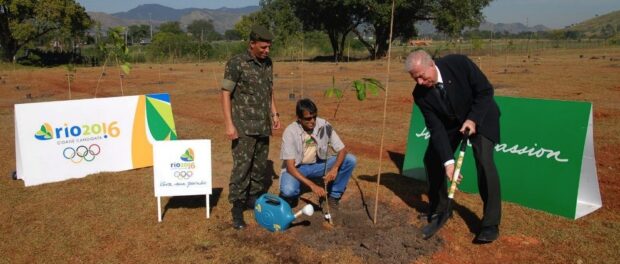
In our last article on rising temperatures in Rio de Janeiro, we discussed heat islands and the unequal distribution of extreme heat throughout the metropolitan area. Recently, Rio de Janeiro gained notoriety as the Latin American city that will be most severely impacted by the effects of global warming. According to the National Institute of Meteorology (INMET), Rio will experience an increase of 3.8 degrees Celsius by 2080. While the year seems far off and the increment small, these increasing temperatures will mean more days of extreme temperatures, like October 15 and 16 last year when temperatures reached 42.8 degrees Celsius, and 38 degrees just last week when the thermal sensation was of 55 degrees Celsius.
As we wade into summer, such extremely high temperatures are becoming more and more common. Cariocas from different backgrounds experience this heat in a variety of ways. Some simply feel an increased discomfort on hot days, while others experience severe medical issues such as those linked to low blood pressure and dehydration.
Carioca perceptions of heat
In order to better understand how cariocas handle the heat, RioOnWatch interviewed residents in Rio’s hottest (Bangu, in the West Zone) and coolest neighborhoods (Leblon, Gávea, Ipanema, and Jardim Botânico in the South Zone).
Both in the South and West Zones, interviewees frequently cited taking showers and staying hydrated by drinking water as ways to manage on hot days. A few also mentioned wearing lighter clothing. Two male professionals cited wearing suits to work as an intense source of discomfort on hot days. Several people said they feel uncomfortably hot in the street and about half actively take care to avoid the street during the summer. Those who can, such as retired people and students with more flexible hours, stay home and avoid going out on hot days.
Some answers appeared to vary depending on the neighborhood. In Bangu half the people we spoke with said they always or frequently feel uncomfortable due to high temperatures. In the South Zone, about one third cited feeling uncomfortable always or frequently. One individual in Jardim Botânico cited the proximity of the lagoon, beaches and forest as having a cooling effect on her neighborhood.
On average, interviewees in Bangu reported spending 4.5 hours in the sun each day. In Jardim Botânico and Leblon, in contrast, most interviewees said they spent little time in the sun, citing commutes to work or school as their only required time outside. This indicates that residents in the South Zone are better able to avoid summer heat than are residents in Bangu. Factors such as a short commute time, an indoor work environment, and ability to maintain a cool and comfortable home environment all mitigate one’s exposure to the negative impacts of extreme heat; it’s important to note these factors are more likely to occur in the wealthier, and often already cooler, regions of the metropolitan region.
Heat-related illnesses are of special concern as they tend to affect already vulnerable populations such as the elderly and children. Two-thirds of interviewees in Bangu said they or someone they knew had experienced heat-related illnesses. In the South Zone about half said they knew someone with heat-related illnesses. One person from the South Zone cited a friend who lived in the North Zone.
How to mitigate heat in our communities
About half of the people we spoke with stated that they believed planting more trees was a key way to mitigate intense heat in their communities. Research suggests just one tree alone has the cooling effect of five air conditioners. Tree cover is often related to class. Richer neighborhoods are more likely to have a higher tree cover allowing for more shade, while poorer neighborhoods often lack trees. In Leblon and Jardim Botânico, for example, trees line public sidewalks and squares, providing shade and the cooling effects from evapotranspiration (the release of water vapor). In the North and West Zones, there is a noticeable lack of public investment in tree planting. Additionally, according to Richieri Antonio Sartori, biology professor at PUC-Rio, more trees would be useful in mitigating heat but substantial tree-planting projects are unlikely to take precedence in the North and West Zones.
Given the potential of tree cover, it is unfortunate the government has abandoned its promise to plant 24 to 34 million trees ahead of the 2016 Olympic Games. The City claims it is currently developing other plans for expanding tree cover across the city as a tool to counter extreme temperatures.
Rio’s participation in projects such as the Urban Climate Change Research Network and the C40 Compact of Mayors implies, at least on paper, a dedication to building resilience to the effects of increasing temperatures. Unfortunately, the long-term aspirational nature of participating in such pacts means little for actual implementation on a schedule that impacts people’s lives here and now, and may well just be another example of ‘For the English to See‘ . With yet another hot summer arriving, short-term strategies to mitigate extreme heat in places like Bangu will be critical to the health and comfort of residents. One resident of Jardim Botânico stated: “The sun is a part of life in Rio. We have to deal with the heat.” But residents of other parts of Rio will need more concrete plans than that.


